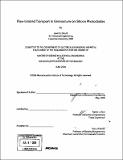| dc.contributor.advisor | Rajeev J. Ram. | en_US |
| dc.contributor.author | Orcutt, Jason S. (Jason Scott) | en_US |
| dc.contributor.other | Massachusetts Institute of Technology. Dept. of Electrical Engineering and Computer Science. | en_US |
| dc.date.accessioned | 2009-06-30T16:11:39Z | |
| dc.date.available | 2009-06-30T16:11:39Z | |
| dc.date.copyright | 2008 | en_US |
| dc.date.issued | 2008 | en_US |
| dc.identifier.uri | http://hdl.handle.net/1721.1/45751 | |
| dc.description | Thesis (S.M.)--Massachusetts Institute of Technology, Dept. of Electrical Engineering and Computer Science, 2008. | en_US |
| dc.description | Includes bibliographical references (p. 201-206). | en_US |
| dc.description.abstract | Epitaxial germanium growth on silicon substrates has enabled a new class of photodiodes that can be integrated with traditional silicon electronics. Previous workers using lowthroughput growth techniques have demonstrated device functionality sufficient for many applications. To enable commercial integration, however, similar performance must be achieved using high throughput epitaxy. In this work, the current performance of germanium-on-silicon photodiodes fabricated by MIT colleagues using one such technique, low pressure chemical vapor deposition (LPCVD), is analyzed. The measured electrical characteristics of multiple diode geometries are fit to finite-element simulation to extract bulk and surface generation rates as a function of bias voltage. The extracted rates are then fit in conjunction with known states from the germanium defect literature to find the densities and field dependant cross sections of physical flaws believed to limit this promising class of devices. General interest photodiode performance is then quantified by optoelectronic measurements and analyzed in the context of the flaw limited transport. Device applicability for integration with an existing photonic sampling system is analyzed and intersymbol interference, noise and linearity metrics are measured and discussed. In conclusion, a pathway for improved devices based upon improved fabrication techniques to reduce identified flaw densities combined with changes in device design is proposed. | en_US |
| dc.description.statementofresponsibility | by Jason S. Orcutt. | en_US |
| dc.format.extent | 206 p. | en_US |
| dc.language.iso | eng | en_US |
| dc.publisher | Massachusetts Institute of Technology | en_US |
| dc.rights | M.I.T. theses are protected by
copyright. They may be viewed from this source for any purpose, but
reproduction or distribution in any format is prohibited without written
permission. See provided URL for inquiries about permission. | en_US |
| dc.rights.uri | http://dspace.mit.edu/handle/1721.1/7582 | en_US |
| dc.subject | Electrical Engineering and Computer Science. | en_US |
| dc.title | Flaw-limited transport in germanium-on-silicon photodiodes | en_US |
| dc.type | Thesis | en_US |
| dc.description.degree | S.M. | en_US |
| dc.contributor.department | Massachusetts Institute of Technology. Department of Electrical Engineering and Computer Science | |
| dc.identifier.oclc | 298254533 | en_US |
